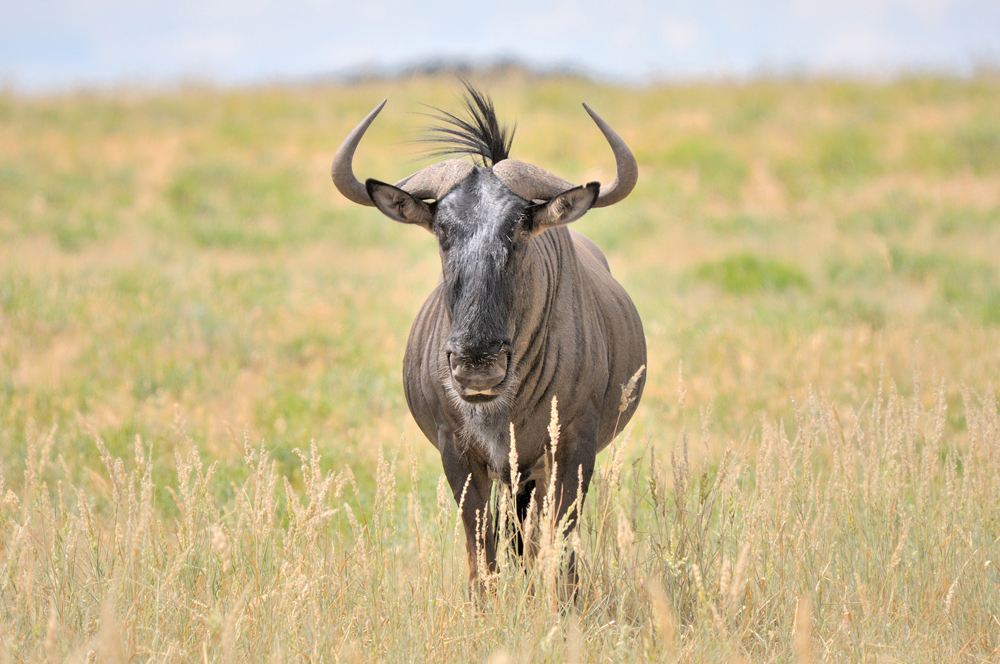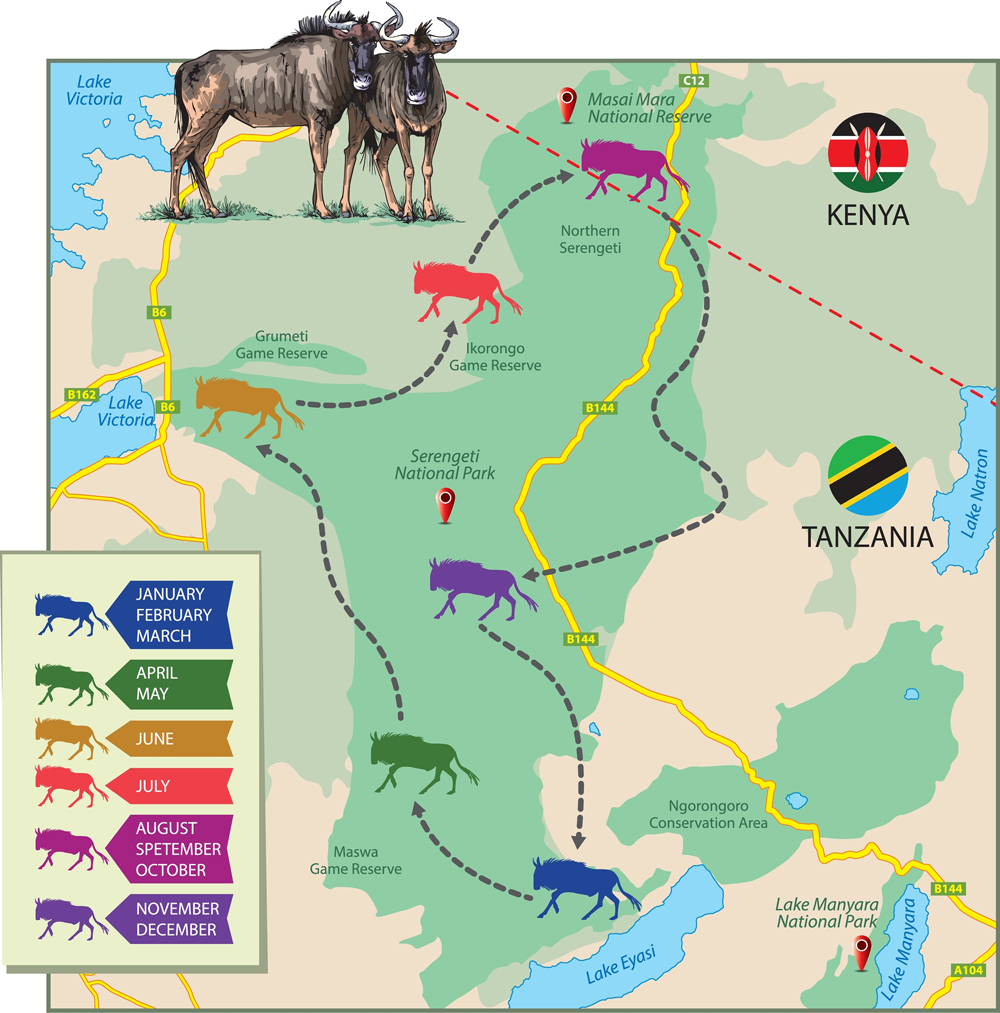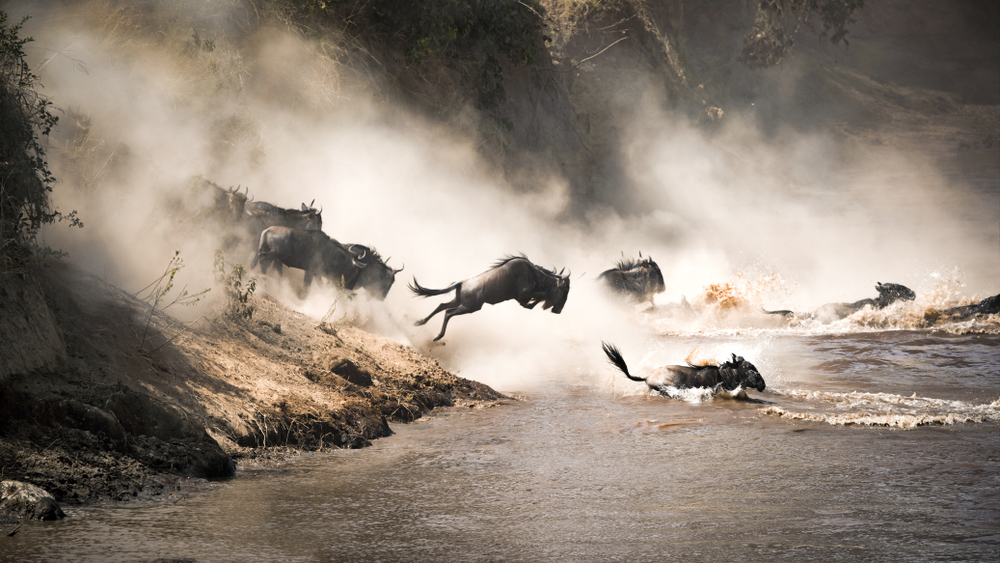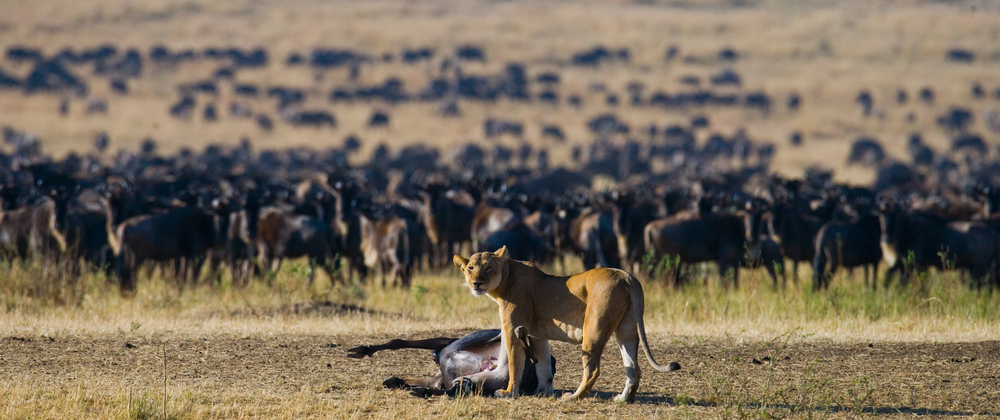Table of Contents (click to expand)
The Great wildebeest migration is a cyclical migration between the Serengeti in Tanzania and Masai Mara in Kenya. The wildebeests follow the rainfall, spending the wet season in the Serengeti (January to April) and the dry period in the Masai Mara acacia woodlands (July to October).
Every year, millions of wildebeest embark on an epic 2000 km (1,200 mile) journey from the Serengeti in Tanzania to the Masai Mara in Kenya. It is referred to as the Great Migration.

The journey is full of peril. At every turn, there are crocodiles hiding in the rivers, as well as hungry lionesses and hyenas stalking through the bush. However, others also share the rich African plains—zebra, Grant’s gazelle, Thomson’s gazelle, elands and impalas—and accompany the wildebeest on their journey.
Why do the wildebeest brave such struggles, rather than remaining in one comfortable and familiar location?
The Great Wildebeest Migratory Route
Not all wildebeest migrate, but those that do are the blue wildebeest Connochaetes taurinus. They travel in a circle within the Serengeti and Masai Mara ecosystem. This route is one the animals have followed since the Pleistocene Age.
The wildebeest are following the rains, which mean two things—food (mainly vegetation) and water.
The wildebeest and other migrating mammals follow the rains to the Serengeti in Tanzania, where they spend January to May, the peak rainy months.
Between January and March, the wildebeest inhabit the southeast of the Serengeti, around Ndutu. Here, the wildebeest give birth to their young.
All the pregnant females of the herd give birth during this short window of time. This synchrony in their birthing season is important for the young to survive. For the first few months, a young wildebeest calf is vulnerable to predators or getting left behind by the herd. By synchronizing the birthing period, the wildebeest calves remain secure within a large group. When it’s time to migrate once more, the calves are old enough to keep up with their herd.
They share this space with fellow migrators, primarily zebras and Thomson’s gazelles.

As the rains decrease and the herd diminishes across the Serengeti, in April, the wildebeest make their way north to the Acacia woodlands in the Masai Mara in Kenya.
However, to reach the lush and juicy Acacia haven of the Mara, the wildebeest must cross rivers teeming with hungry crocodiles. The rush and the panic can also cause stampedes. When something like this happens, it’s every wildebeest for itself; even the calves must keep up or they will get left behind.
However, once they are past the rivers, the Masai Mara is their home until December, when the rains return to the Serengeti, and the cycle of migration begins once again.

How Does The Ecosystem Feed So Many Herbivores?
With so many herbivores munching on grass and leaves, how is it that there is enough for everyone? A team of researchers from Princeton University, the Smithsonian Institute in the USA, and Mpala Research Centre in Kenya researched this exact question. They found that each of the herbivores eat only certain species of grass, so the herbivores won’t compete for food, as they each have their preferences.
Also Read: What Do We Know About The Terai-Duar, The Savanna At The Foothills Of The Himalayas?
Why Do The Wildebeests Migrate?
Though researchers have extensively studied this magnificent migration, we still don’t fully understand why the animals undertake the arduous journey. The wildebeests follow the rainfall to the Serengeti, but throughout the year, the Masai Mara receives more rainfall. So why go through the journey every year?
Scientists have some guesses.
Some hypothesize that the Serengeti has higher forage capacity and better quality food. Others suggest that the wildebeest migrate to escape predators.
One research team suggested that the wildebeest migrated because of grass. Tree cover in the acacia woodlands doesn’t allow grasses to thrive, unlike the flat plains of the Serengeti. The grasses in the Serengeti are rich in nitrogen and phosphorus—two essential nutrients.
There are no conclusive answers, but nonetheless, the wildebeests charge ahead, as they have been doing for more than a million years.
Also Read: What Is Rewilding And Why Is It Important?
Why Is This Migration Important?
Wildebeest migrations keep the Serengeti healthy.
Wildebeests are a keystone species in the ecosystem. This means that they are a crucial species in an ecosystem, one that affects the ecosystem disproportionately compared to other species. In other words, taking the wildebeest out of this ecosystem or preventing them from migrating would have a massively negative impact on the ecosystem.
The wildebeest, along with their fellow migrators, grazed the grass in the Serengeti plain, basically trimming them to keep them healthy. Their trampling also helps with pollination.
They provide food for predators like lions, leopards, cheetahs, wild dogs, hyenas, vultures and numerous others that call this ecosystem home.

Their carcasses eventually feed the Earth, keeping the soil healthy.
A Final Word
Humans are encroaching on the lands of the Serengeti and Masai Mara. Roads, fences, the poorly planned expansion of agriculture and settlements, poaching, and increased competition for livestock are all threatening this annual migration.
Though the wildebeest population still stands at a healthy 1.3 million individuals, the numbers that migrate each year are decreasing.
Fortunately, efforts to protect the region are under way. Conservationists, ecologists and policy makers are trying to protect the reserves to ensure that one of the greatest migration events on the planet isn’t lost forever.
How well do you understand the article above!

References (click to expand)
- Subalusky, A. L., Dutton, C. L., Rosi, E. J., & Post, D. M. (2017, June 19). Annual mass drownings of the Serengeti wildebeest migration influence nutrient cycling and storage in the Mara River. Proceedings of the National Academy of Sciences. Proceedings of the National Academy of Sciences.
- Eastern Africa: the Greater Serengeti grassland ecosystem in northern Tanzania | Ecoregions | WWF - www.worldwildlife.org
- Holdo, R. M., Holt, R. D., & Fryxell, J. M. (2009, April). Opposing Rainfall and Plant Nutritional Gradients Best Explain the Wildebeest Migration in the Serengeti. The American Naturalist. University of Chicago Press.
